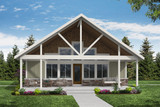Take the First Step Towards Your Dream Home or Garage! Shop Now for Pre-Designed Plans.
Embracing the Essence of Mountain Rustic Architecture

At the heart of the Mountain Rustic ethos lies a profound appreciation for nature's bounty. These homes transcend mere structures; they are harmonious extensions of their breathtaking surroundings. Adorned with natural materials such as wood, stone, and metal, Mountain Rustic exteriors exude an organic elegance that beckons admiration. Clad in wood siding or punctuated with log accents, these dwellings stand as tributes to the rugged landscapes they inhabit, with stone chimneys and metal roofing completing the picturesque tableau. Each element, from the exposed beams to the reclaimed wood, tells a story of resilience and timelessness, adding to the allure of these architectural marvels.
Yet, it is the seamless integration of outdoor living spaces that truly sets Mountain Rustic homes apart. Covered porches and decks serve as sanctuaries where one can commune with nature, enveloped in the majesty of mountain panoramas. Equipped with fireplaces, outdoor kitchens, and plush seating areas, these extensions of the home blur the boundaries between indoor and outdoor living, offering a haven for relaxation and entertainment alike.
As the allure of Mountain Rustic living continues to captivate discerning homeowners, a convergence of tradition and innovation emerges. Modern amenities, from home theaters to spa-like bathrooms, are seamlessly integrated into the fabric of these homes, offering a symphony of comfort and convenience amidst rustic grandeur. Here, residents can immerse themselves in the timeless charm of a mountain retreat without sacrificing the luxuries of modern living—a testament to the versatility and adaptability of Mountain Rustic design.
Pros and Cons of Mountain Rustic House Plans
Before delving deeper into the allure of Mountain Rustic house plans, it's essential to weigh the inherent advantages and potential drawbacks of this architectural style. Like any design choice, Mountain Rustic homes come with their own set of pros and cons, each playing a crucial role in shaping the homeowner's experience and satisfaction.
Pros of Mountain Rustic Home Designs:
Natural Aesthetic: Mountain Rustic homes offer a visually striking aesthetic that seamlessly blends with their natural surroundings. The use of natural materials like wood and stone creates a sense of harmony with the environment, making these homes an appealing choice for nature enthusiasts.
Timeless Charm: With their classic design elements and rustic appeal, Mountain Rustic house plans exude a timeless charm that transcends passing trends. These homes evoke a sense of nostalgia and authenticity, making them enduring symbols of architectural elegance.
Outdoor Living Spaces: One of the standout features of Mountain Rustic homes is their emphasis on outdoor living. Covered porches, decks, and patios provide ample space for relaxation and entertainment, allowing homeowners to fully immerse themselves in the beauty of their natural surroundings.
Versatility: Despite their rustic exterior, Mountain Rustic house plans often incorporate modern amenities and design elements, offering a perfect blend of traditional charm and contemporary comfort. This versatility makes them suitable for a wide range of lifestyles and preferences.
Resale Value: Due to their timeless appeal and enduring popularity, Mountain Rustic homes often retain their value well over time. Whether as primary residences or vacation retreats, these properties are highly sought after in the real estate market, making them a sound investment for homeowners.
Cons of Mountain Rustic Designs:
Maintenance Requirements: The natural materials used in Mountain Rustic homes, such as wood and stone, may require regular maintenance to preserve their appearance and structural integrity. This can involve tasks such as sealing, staining, or repairing exterior surfaces, which may entail additional time and expense.
Cost: While the allure of Mountain Rustic living is undeniable, the initial cost of building or purchasing a home in this style can be higher compared to more conventional designs. Factors such as the use of high-quality materials and custom craftsmanship contribute to the overall expense of these homes.
Limited Availability: Mountain Rustic homes may not be readily available in all geographic locations, particularly in urban or suburban areas where land constraints and zoning regulations may limit their construction. As such, finding the perfect location for a Mountain Rustic retreat may require patience and diligence.
Energy Efficiency: Due to their emphasis on natural materials and expansive outdoor living spaces, Mountain Rustic homes may have lower energy efficiency compared to more modern designs. Heating and cooling costs can be higher, especially in regions with extreme climate conditions, necessitating thoughtful planning and investment in energy-efficient features.
Design Constraints: While Mountain Rustic house plans offer a blend of traditional charm and modern convenience, they may not appeal to every homeowner's aesthetic preferences. The rustic aesthetic may clash with contemporary or minimalist design sensibilities, limiting the appeal of these homes to a specific demographic.
A Journey Through Time: Tracing the Roots of Mountain Rustic Architecture
The history of mountain rustic architecture is deeply intertwined with the rugged landscapes and cultural heritage of mountainous regions across the globe. While specific architectural styles may vary depending on geographical location and cultural influences, the essence of mountain rustic design can be traced back to the origins of human civilization.
Historically, mountain regions have been home to communities that relied on local materials and traditional building techniques to construct dwellings suited to their harsh environments. In Europe, for example, the Alpine regions gave rise to distinctive mountain architecture characterized by sturdy stone structures with steeply pitched roofs designed to shed heavy snowfall. Similarly, in the Appalachian Mountains of North America, early settlers built log cabins using logs harvested from nearby forests, a practice that laid the foundation for the rustic aesthetic that persists to this day.
The emergence of mountain rustic architecture as a distinct architectural style can be attributed to a convergence of factors, including advancements in construction technology, shifting cultural preferences, and the rise of leisure tourism. In the late 19th and early 20th centuries, wealthy urbanites seeking refuge from the hustle and bustle of city life began flocking to mountain retreats in search of fresh air, stunning scenery, and outdoor recreation. This led to the development of mountain resorts and the construction of grand rustic lodges and cottages designed to cater to the burgeoning tourist trade.
One of the most influential figures in the popularization of mountain rustic architecture was the renowned American architect, Frank Lloyd Wright. Wright's iconic Prairie Style architecture, with its emphasis on organic integration with the natural environment, served as a precursor to the rustic modernist movement that would later take root in mountainous regions around the world. Wright's philosophy of "organic architecture," which sought to create buildings that harmonized with their surroundings, inspired a new generation of architects to embrace natural materials and vernacular building techniques in their designs.
Throughout the 20th century, mountain rustic architecture continued to evolve, adapting to changing tastes and technological innovations while remaining true to its rustic roots. The post-war era saw a resurgence of interest in rustic design, fueled in part by the romanticism of the American West and the popularity of outdoor recreational activities such as skiing, hiking, and fishing. Architects and designers began incorporating elements of mountain rustic style into a wide range.
Choosing Associated Designs for Your Mountain Rustic Home
The allure of Mountain Rustic architecture lies in its seamless integration with nature, timeless charm, and versatile design elements. From the organic elegance of exterior facades adorned with natural materials to the inviting warmth of interiors marrying rustic charm with modern luxury, Mountain Rustic homes offer a sanctuary amidst breathtaking landscapes. The emphasis on outdoor living spaces and the integration of modern amenities further enhance the appeal of these architectural marvels, catering to the desires of discerning homeowners seeking a harmonious blend of tradition and innovation.
When considering your options for bringing your Mountain Rustic dream home to life, Associated Designs stands out as a premier design source. With a rich portfolio of Mountain Rustic house plans crafted by experienced architects, Associated Designs offers a diverse array of designs to suit every taste and lifestyle. Whether you're envisioning a cozy cabin retreat or a grand mountain estate, Associated Designs provides meticulously crafted floor plans and expert guidance to help you realize your vision.
Moreover, Associated Designs understands the unique challenges and opportunities inherent in Mountain Rustic architecture. Their team of seasoned professionals possesses the expertise and creativity needed to navigate the complexities of designing homes that harmonize with their natural surroundings while meeting the demands of modern living. From site-specific considerations to energy-efficient design solutions, Associated Designs ensures that your Mountain Rustic home is not only aesthetically stunning but also practical and sustainable.

